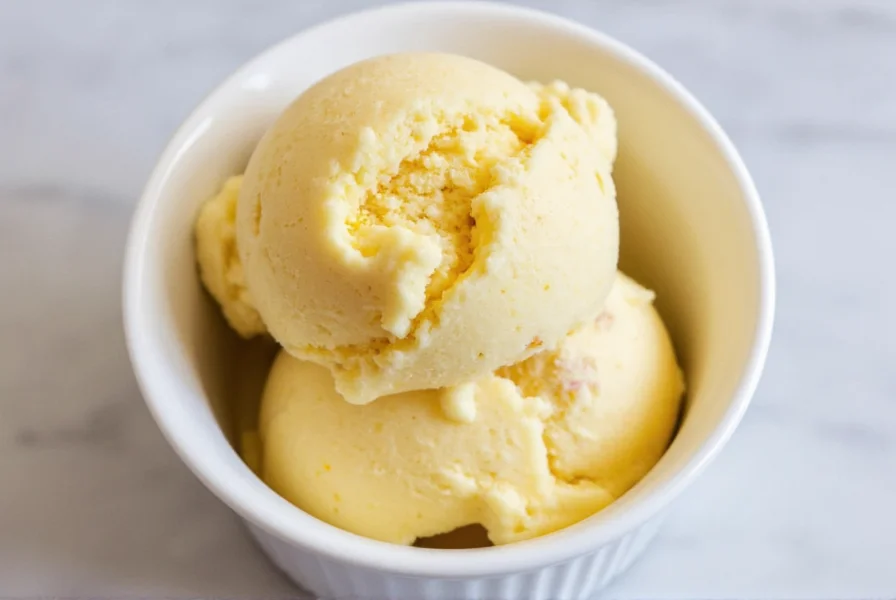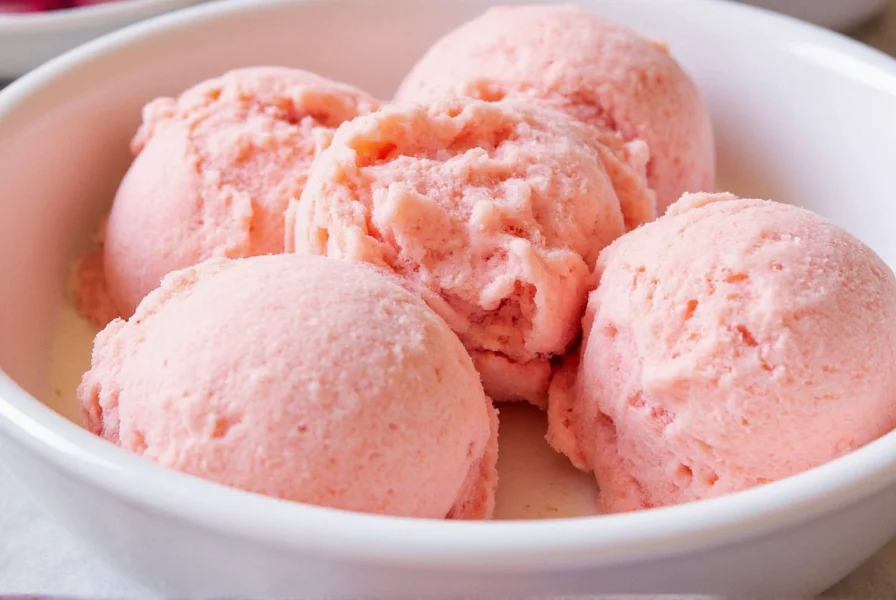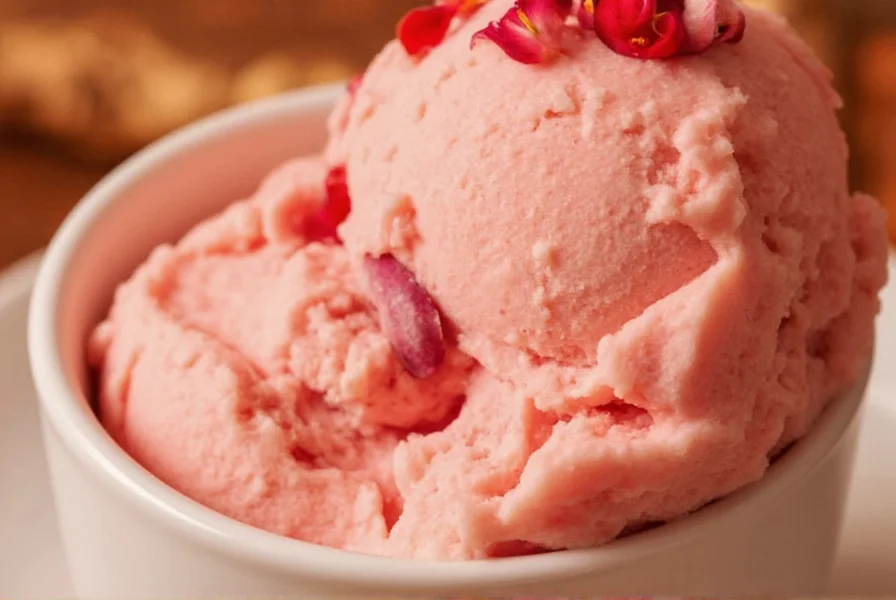Saffron rose ice cream represents a beautiful marriage of two prized ingredients with deep cultural roots in Middle Eastern and South Asian culinary traditions. The vibrant golden color comes from steeping genuine saffron threads, while the floral essence derives from high-quality rose water. Unlike artificial versions, authentic saffron rose ice cream avoids overwhelming sweetness, allowing the nuanced flavors to shine through in perfect harmony.
The Distinctive Flavor Profile of Saffron and Rose
Understanding saffron rose ice cream requires appreciating how these two premium ingredients interact. Saffron contributes more than just color—it delivers a complex flavor profile with hints of honey, hay, and subtle earthiness. When combined with rose water's delicate floral notes, the result is a sophisticated dessert that avoids cloying sweetness. The magic happens when these elements balance perfectly: too much rose water becomes perfumey, while insufficient saffron fails to provide that characteristic golden hue and distinctive aroma.
Professional ice cream makers emphasize using culinary-grade saffron threads rather than powder for optimal flavor extraction. Similarly, rose water quality dramatically impacts the final product—authentic Persian rose water made from Damask roses produces superior results compared to cheaper alternatives. This attention to ingredient quality separates exceptional saffron rose ice cream from mediocre versions.
| Ingredient | Quality Indicator | Impact on Final Product |
|---|---|---|
| Saffron | Deep red threads with orange stigma tips | Bright golden color, complex honey-like flavor |
| Rose Water | Natural distillation, no artificial colors | Delicate floral notes without chemical aftertaste |
| Cream Base | High butterfat content (14-18%) | Smooth texture that carries delicate flavors |
Cultural Heritage of Floral and Saffron Flavors
The tradition of combining saffron and rose in desserts traces back centuries across Persian, Indian, and Mediterranean cultures. In Iran, this flavor combination appears in faloodeh (a traditional Persian frozen dessert) and various rice puddings. Indian kulfi often features similar floral and saffron elements, while Ottoman cuisine incorporated these ingredients into milk-based desserts.
Historically, saffron's status as one of the world's most expensive spices made it a symbol of luxury and hospitality. Rose water production through steam distillation of Damask roses dates back to at least the 7th century in Persia. When European explorers encountered these flavors, they incorporated them into their own frozen dessert traditions, eventually influencing modern artisanal ice cream production.

Creating Authentic Saffron Rose Ice Cream
While commercial versions exist, crafting genuine saffron rose ice cream requires careful technique. The process begins by steeping saffron threads in warm cream or milk—never boiling water, which destroys delicate flavor compounds. Most traditional recipes use a 1:3 ratio of saffron to rose water to achieve balance.
Professional ice cream makers recommend adding rose water after the base has cooled slightly to preserve its volatile aromatic compounds. The ideal temperature for incorporation is between 110-120°F (43-49°C). Over-churning can diminish the floral notes, so many artisans stop the machine just before the ice cream reaches full firmness.
Perfect Pairings and Serving Suggestions
Saffron rose ice cream shines when paired thoughtfully. Traditional Persian accompaniments include:
- Gaz - Iranian nougat with pistachios and rose water
- Baklava - Particularly pistachio varieties
- Fresh fruit - Sliced peaches or apricots complement the floral notes
- Tea - Strong black tea with a hint of cardamom
For modern presentations, consider serving saffron rose ice cream with a drizzle of date syrup or alongside delicate shortbread cookies. The key is maintaining balance—avoid competing flavors that might overwhelm the subtle saffron and rose notes. Many chefs recommend serving this ice cream slightly warmer than standard varieties to enhance the aromatic experience.

Finding Authentic Saffron Rose Ice Cream
Locating genuinely crafted saffron rose ice cream requires knowing what to look for. Authentic versions display a pale golden color (not bright yellow from artificial coloring) and feature visible saffron threads. The flavor should be fragrant but not overpowering, with no chemical aftertaste from low-quality rose water.
Specialty Middle Eastern markets, Persian grocery stores, and artisanal ice cream shops in areas with significant Iranian or Indian communities often carry the most authentic versions. When purchasing, check ingredient lists for natural components—real saffron threads, genuine rose water, and dairy ingredients without artificial flavors or excessive stabilizers.
Conclusion: A Timeless Flavor Combination
Saffron rose ice cream represents more than just a frozen dessert—it's a connection to centuries of culinary tradition where premium ingredients were used to create memorable hospitality experiences. This sophisticated flavor combination continues to captivate modern palates precisely because it respects its heritage while adapting to contemporary tastes. Whether enjoyed in a traditional setting or as a refined finish to a modern meal, saffron rose ice cream offers a distinctive sensory experience that elevates simple ingredients into something extraordinary.
Frequently Asked Questions
What gives saffron rose ice cream its distinctive color?
The golden hue comes exclusively from genuine saffron threads. High-quality saffron releases crocin, a natural carotenoid pigment, when steeped in warm dairy. Artificial versions often use yellow food coloring, but authentic saffron ice cream shows a delicate golden color without being unnaturally bright.
How can I tell if saffron rose ice cream is authentic?
Authentic versions display three key characteristics: visible saffron threads, a pale golden color (not bright yellow), and a balanced flavor where neither saffron nor rose dominates. The texture should be creamy without iciness, and the ingredient list should contain real saffron and rose water without artificial flavors or excessive stabilizers.
Does saffron rose ice cream contain actual rose petals?
Traditional recipes use rose water (distilled from rose petals) rather than actual petals. Some artisanal versions may include edible rose petals as garnish, but the floral flavor primarily comes from high-quality rose water. The saffron component always comes from the stigmas of Crocus sativus flowers, never from artificial coloring.
What's the difference between saffron ice cream and saffron rose ice cream?
Saffron ice cream features only saffron flavoring, resulting in a more straightforward earthy-sweet profile with prominent honey notes. Saffron rose ice cream combines both ingredients, creating a more complex flavor where the floral rose notes balance saffron's intensity. The rose component adds aromatic complexity while softening saffron's sometimes assertive character.
Can I make saffron rose ice cream without an ice cream maker?
Yes, you can create a version without specialized equipment using the 'freezer-stir' method. Prepare your custard base with steeped saffron and rose water, then pour into a shallow container. Freeze for 1-2 hours until partially set, then vigorously stir to break up ice crystals. Repeat every 30 minutes for 3-4 cycles. While the texture won't match machine-churned versions, it produces a serviceable homemade alternative.











 浙公网安备
33010002000092号
浙公网安备
33010002000092号 浙B2-20120091-4
浙B2-20120091-4